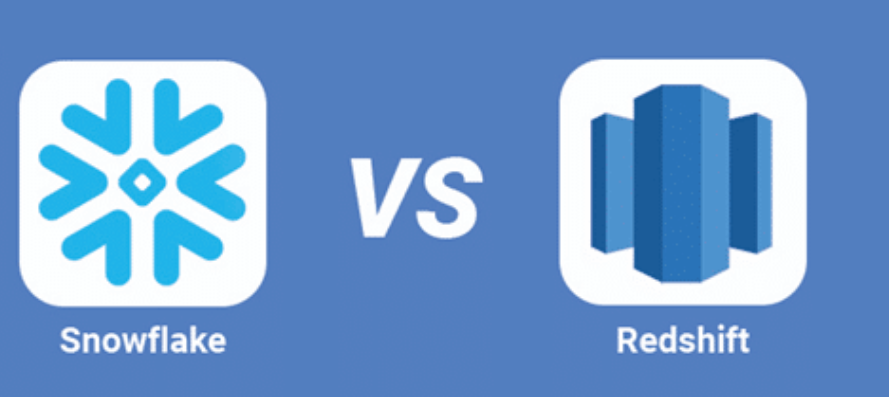Excerpt: The evolution of cloud-based services revolutionized the business world. Furthermore, digital transformation increases business competitiveness. Because of cloud services, the company can easily retrieve or store data about their customers, products, or employees for future business decisions.
Introduction:
Data is the lifeblood of businesses, and more and more companies are turning to data warehouses to organize their data. For businesses, the findings are more data-driven; all the data they collect must end up in the best place for analytics: a high-performance data warehouse in the cloud. However, choosing the best data warehouse appears to be the most challenging task for any business among many options. When it comes to data warehouses, the top players are Snowflake and Redshift. Choosing one over the other is challenging because it is difficult to tell who is superior to whom.
Let’s look at both and see if there are any solutions to choose between two that make sense for your data strategy. To make the best decision, consider the key features and conduct a comparison study. Snowflake and Redshift are full cloud data warehouses offering unique data management options. In order to evaluate your skills in the Data Warehousing Certification Courses platform, Snowflake Training helps a lot.
Snowflake
A relational database management system for structured and semi-structured data is called Snowflake computing. The SQL database engine is used to store information in a database and is primarily powered by the SaaS model. A cloud-based data storage and analytics service provided by Snowflake Computing is called Snowflake Elastic Data Warehouse. Its cloud services include infrastructure management, access controls, queries, and authentication.
With this solution, business users can use cloud-based hardware and software to store and analyze data. The information is then kept in Amazon S3. Instead of relying on tools like Hadoop, Snowflake uses the ecosystem of public clouds.
Redshift
In its marketing materials, AWS Redshift presents itself as a petabyte-scale data warehouse service that BI tools can use for analysis. Users can quickly scale up and down. One of the cool things about this is that as your needs expand, you can start just with a few hundred gigabytes of data and scale up to a petabyte or more. Therefore, all you need to do to begin making wiser business decisions is extract, transform, and load (ETL) data into the warehouse. Companies use their data to learn essential business lessons about themselves or their clients.
You must launch a group of nodes known as a Redshift cluster to throw your cloud data warehouse. The collection is then divided into “slices” by each node. The memory and disc space of the node are divided among the slices. The workload placed on the node is better distributed, improving query performance. After provisioning the cluster, you could upload data sets and run data analysis queries.
Using the same SQL-based tools and BI applications, you can benefit from quick query performance irrespective of the size of your data set.
Snowflake vs. Redshift for the following features
- Integration and Performance
If your company is already committed to AWS, Redshift may seem the best option. Snowflake, however, is also available in the AWS Marketplace and has on-demand features.
- Several AWS services, including Kinesis Data Firehose, SageMaker, EMR, Glue, DynamoDB, Athena, Database Migration Service (DMS), Schema Conversion Tools (SCT), CloudWatch, etc., are integrated with Redshift.
- Although Snowflake is listed on the AWS Marketplace, it is not as deeply integrated into the AWS ecosystem. It lacks the depth and breadth of vendor partnerships that Amazon can muster.
- It’s crucial to remember that Snowflake doesn’t have the same integrations as Redshift if you’re considering using it. As a result, integrating the data warehouse with programs like Athena or Glue becomes difficult.
- Snowflake makes up for this, though, with a wide range of integration options, including Tableau, IBM Cognos, Qlik, and Apache Spark, to name a few.
Both options have a robust ecosystem of partners and extensive integrations. Redshift is more well-known and has an advantage, but Snowflake has made progress.
- Pricing
Both products have on-demand pricing as a feature. But the packaging strategy used by these two data warehouse platforms varies.
- Redshift ETL and Snowflake ETL have very different pricing structures. When it comes to on-demand pricing, Redshift is less expensive if you look more closely. Both solutions offer discounts ranging from 30% to 70% for businesses that opt to prepay.
- It’s crucial to remember that significant data provider warehouses use various pricing strategies.
The pricing model of Redshift’s
Redshift Monthly Cost = Hourly Rate x Cluster Size x Monthly Hours
- Redshift bills hourly per node, including computing capacity and data storage. By dividing the price per hour by the size of the cluster and the number of hours in a month, you can use Redshift to determine the monthly cost.
The pricing model of Snowflake
- Your monthly usage habits heavily influence the cost of Snowflake. This is because each bill is produced hourly for each virtual data warehouse. Data storage is separately billed from computational warehouses because they are not connected.
- Snowflake offers a dynamic pricing structure; clusters can flexibly resize themselves in response to changing workloads and will automatically halt when no queries are running and resume when they are. Costs associated with data storage will also be distinct from those associated with computation.
- Snowflake includes five editions, each with a progressively more expensive set of extra features. One can decide to cut costs on features that don’t meet their business needs by choosing to remove some of the features.
In terms of on-demand pricing, it is evident that Redshift is less expensive than Snowflake. Before selecting Snowflake or Redshift, it is crucial to consider the resources required for the business’s unique data volume, data processing needs, and requirements for data analysis. Selecting the right data warehouse might deliver an enhanced long-term ROI through continual learning of speed, accuracy, and efficiency of data-driven actions.
- Security
The core of every big data project is security. With new data sources constantly creating potential vulnerabilities, maintaining it cannot be easy. Given that both services provide high protection, there is no difference between Amazon Redshift and Snowflake in terms of security.
- Redshift achieves some significant compliance and security goals. All users are subject to full enforcement of these features. Access management, cluster encryption, security groups for clusters, data encryption in transit and at rest, SSL connection security, and sign-in credential security are available supplemental tools. Access rights can be very localized and are granular.
Redshift’s closest competitor, Snowflake offers
- Features and tools for security and regulatory compliance. One must be careful when selecting a version because some versions lack specific features.
- Redshift provides end-to-end encryption, which can be tailored to satisfy any security requirement. A VPN connection can isolate the network within a VPC and connect it to an existing IT infrastructure. Apart from its always-on encryption and VPC/VPN network isolation features, Snowflake differs significantly from Redshift regarding the breadth of its security and compliance capabilities.
- Database Features
- If we talk about Snowflake first, then With Snowflake, data sharing between various accounts is incredibly simple. The data can be shared with other users and clients without having to be copied. This method of using third-party data is effective and has the potential to spread across all platforms.
- Snowflake is incredibly effective when it comes to managing data from third parties. Redshift does not currently provide the same capability. Redshift does not support semi-structured data types like an object, array, and variant, unlike Snowflake.
- When taking the scenario of strings- Redshift Varchar has a data type limit of 65535 characters for Strings. The column length must also be selected in advance.
- The maximum String size in Snowflake is 16MB, and this value is always used (with no performance penalty). Therefore, you are exempt from knowing the String size value at the start of the exercise.
- Maintenance
- Users of Redshift must look at the same cluster and compete for the same resources. WLM queues need to be managed, which can be difficult, especially about comprehending a complicated set of rules.
- Snowflake doesn’t have this issue. To view the same data without copying it, you can quickly start various data warehouses of multiple sizes. Therefore, it is simple to assign these to different users and tasks.
- Snowflake triumphs in the Redshift vs. Snowflake argument when it comes to routinely vacuuming and analyzing tables.
- Redshift encounters difficulties when scaling up or down. Additionally, it gets costly and may cause a lot of downtimes. There is no need to duplicate data to scale up or down in Snowflake because storage and computing are separate. You can change the data computing capacity however you like.
Now let us take you to some of the pros and cons of both Snowflake and Redshift for better understanding and decision-making:
Redshift’s pros
- If the data is stored on Amazon S3 and the scaling of the compute and storage is permitted independently, its spectrum can quickly execute complex queries.
- Amazon Redshift is very easy to use. It also requires hardly any administrative effort. For instance, setting up a cluster, choosing an instance type, and managing scaling are all needed.
- It offers quick, secure, and dependable backup.
- Both data storage and compute power per node are available hourly on-demand pricing.
- When reporting, it works well for aggregating or deformalizing data.
- Pricing for reserved instances available on demand includes computing power and data storage, calculated per hour and node.
- Amazon offers improved database security capabilities and a robust integrated compliance program.
Redshift’s cons
- Its language is comparable to PostgreSQL 8.
- It occasionally has problems with queries in external tables hanging.
- There are no enforced constraints, so you must rely on other methods to ensure the integrity of the transformed tables.
- Not suitable for systems that conduct transactions.
- Whereas you wait for AWS to release a new patch, you may occasionally need to roll back to an earlier version of Redshift.
- The amount charged by Amazon Redshift Spectrum depends on how many bytes are scanned.
- Redshift only uses primary key and essential foreign information. The system does not require uniqueness. As a result, you’ll need to use another method to eliminate duplicate data.
Snowflake pros
- For businesses that operate primarily in the cloud, Snowflake works excellently. This data warehouse solution is straightforward and works with most other technologies.
- It is very user-friendly and works with the majority of other technologies.
- Both setup and operation are simple.
- It offers seamless Amazon AWS integration.
- It supports a variety of partners and third-party technologies.
- It offers user-defined functions and secure views.
Snowflake cons
- It is not the best choice if on-premise technology is used and cannot seamlessly connect with cloud-based services.
- A moment’s worth of Snowflake credits are expended even when a virtual warehouse is launched, and after that, it is charged per second.
- The SQL editor in Snowflake needs to be updated to handle the autocomplete features better than it currently does.
Conclusion:
Redshift or Snowflake should be chosen based on your resources, business needs, and data strategy. The user must decide which of these two excellent data platforms will best suit their data patterns by evaluating their workloads for suitability and weighing their pros and cons. Snowflake or Redshift are both key stops on the way to better business intelligence.
Author Bio:
I am Korra Shailaja, Working as a Digital Marketing professional & Content writer in MindMajix Online Training. I Have good experience in handling technical content writing and aspire to learn new things to grow professionally. I am an expert in delivering content on the market demanding technologies like Mulesoft Training, Dell Boomi Tutorial, Elasticsearch Course, Fortinet Course, PostgreSQL Training, Splunk, Success Factor, Denodo, etc.









